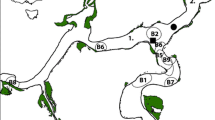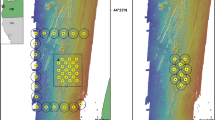Abstract
The California sheephead, Semicossyphus pulcher Ayres (Labridae), is a carnivorous, temperate, rocky-reef/kelp-bed species that is highly sought in recreational and commercial fisheries. Fine-scale acoustic telemetry tracking was used to ascertain the home range and habitat utilization of S. pulcher. Sixteen adult S. pulcher (26–38 cm SL) were surgically fitted with small acoustic transmitters and manually tracked for up to 144 h during multiple, 24-h periods between March 2001 and August 2002 within the Catalina Marine Science Center Marine Life Reserve (33°26′N; 118°29′W). A geographic information system was used to calculate home range sizes (95% kernel utilization distributions) and habitat use. Tracking of the first five fish over 24 h confirmed that S. pulcher were strictly diurnal, so the remaining 11 fish were tracked from 1 h before sunrise to 1 h after sunset. Home ranges varied greatly, from 938 to 82,070 m2, with a mean (±SD) of 15,134±26,007 m2. Variability in home range sizes among fish was attributed to differences in habitat shape (embayment vs. contiguous coastline) and to natural habitat boundaries (deep, sandy expanses) in adjacent areas within the reserve. There was a significant relationship between fish length and proportion of time spent in different habitats (sand vs. reef). S. pulcher were found within rocky-reef areas 54% of the time, and, within these areas, a greater percentage of daytime was spent in high-relief areas. Based on the relatively small size and persistence of home ranges of adult S. pulcher, no-take reserves, if they contain appropriate habitat, would provide adequate protection for their stocks.







Similar content being viewed by others
References
Adreani MS, Erisman BE, Warner RR (2004) Observations of courtship behavior and spawning in the California sheephead, Semicossyphus pulcher (Pisces: Labridae). Environ Biol Fishes 71:13–19
Barrett NS (1995) Short- and long-term movement patterns of six temperate reef fishes (families Labridae and Monacanthidae). Mar Freshw Res 46:853–860
Barrows E (1996) Animal behavior desk reference, 2nd edn. CRC Press, Boca Raton, Fla., USA
Bradbury C, Green JM, Bruce-Lockhart M (1995) Home ranges of female cunner, Tautogolabrus adspersus (Labridae), as determined by ultrasonic telemetry. Can J Zool 73:1268–1279
Brett JR (1965) The relation of size to rate of oxygen consumption and sustained swimming speed of sockeye salmon (Oncorhynchus nerka). J Fish Res Board Can 22:1491–1501
Chapman MR, Kramer DL (2000) Movements of fishes within and among fringing coral reefs in Barbados. Environ Biol Fishes 57:11–24
Cowen RK (1983) The effect of sheephead (Semicossyphus pulcher) predation on red sea urchin (Strongylocentrotus franciscanus) populations: an experimental analysis. Oecologia 58:249–255
Cowen RK (1986) Site-specific differences in the feeding ecology of the California sheephead, Semicossyphus pulcher (Labridae). Environ Biol Fishes 16:193–203
Cowen RK (1990) Sex change and life history patterns of the labrid, Semicossyphus pulcher, across an environmental gradient. Copeia 3:787–795
Dayton PK, Tegner MJ, Edwards PB, Riser KL (1998) Sliding baselines, ghosts, and reduced expectations in kelp forest communities. Ecol Appl 8:309–322
Ebeling AW, Bray RN (1976) Day versus night activity of reef fishes in a kelp forest off Santa Barbara, California. Fish Bull (Wash DC) 74:703–717
Eristhee N, Oxenford HA (2001) Home range size and use of space by Bermuda chub Kyphosus sectatrix (L.) in two marine reserves in the Soufriere Marine Management Area, St Lucia, West Indies. J Fish Biol 59:129–151
Fitch WTS, Shapiro DY (1990) Spatial dispersion and non-migratory spawning in the bluehead wrasse (Thalassoma bifasciatum). Ethology 85:199–211
Gerber LR, Botsford LW, Hastings A, Possingham HP, Gaines SD, Palumbi SR, Andelman S (2003) Population models for marine reserve design: a retrospective and prospective synthesis. Ecol Appl 13:47–64
Harestad AS, Bunnell FL (1979) Home range and body weight—a reevaluation. Ecology 60:389–402
Hobson ES, Chess JR (1986) Relationships among fishes and their prey in a nearshore sand community off southern California. Environ Biol Fishes 17:201–226
Hobson ES, Chess JR (2001) Influence of trophic relations on form and behavior among fishes and benthic invertebrates in some California marine communities. Environ Biol Fishes 60:411–457
Hobson ES, McFarland WN, Chess JR (1981) Crepuscular and nocturnal activities of Californian nearshore fishes, with consideration of their scotopic visual pigments and the photic environment. Fish Bull (Wash DC) 79:1–30
Hoffman SG (1983) Sex-related foraging behavior in sequentially hermaphroditic hogfishes (Bodianus sp.). Ecology 64:798–808
Holland K, Peterson JD, Lowe CG, Wetherbee BM (1993) Movements, distribution and growth rates of the white goatfish Mulloides flavolineatus in a fisheries conservation zone. Bull Mar Sci 52:982–992
Hooge PN, Eichenlaub WM, Solomon EK (1999) The animal movement program. USGS, Alaska Biological Science Center, Fairbanks
Hooge PN, Eichenlaub WM, Solomon EK (2001) Using GIS to analyze animal movements in the marine environment. In: Kruse GH, Bez N, Booth A, Dorn MW, Hills S, Lipcius RN, Pelletier D, Roy C, Smith SJ, Witherell D (eds) Spatial processes and management of marine populations. University of Alaska Sea Grant College, Fairbanks, pp 37–51
Johnson DR, Funicelli NA, Bohnsack JA (1999) Effectiveness of an existing estuarine no-take fish sanctuary within the Kennedy Space Center, Florida. N Am J Fish Manage 19:436–453
Johnson TD, Barnett AM, Demartini EE, Craft LL, Ambrose RF, Purcell LJ (1994) Fish production and habitat utilization on a southern California artificial reef. Bull Mar Sci 55:709–723
Kramer D, Chapman M (1999) Implications of fish home range size and relocation for marine reserve function. Environ Biol Fishes 55:65–79
Lowe CG, Topping DT, Cartamil DP, Papastamatiou YP (2003) Movement patterns, home range and habitat utilization of adult kelp bass (Paralabrax clathratus) in a temperate no-take marine reserve. Mar Ecol Prog Ser 256:205–216
Martel G, Green JM (1987) Differential spawning success among territorial male cunners, Tautogolabrus adspersus (Labridae). Copeia 3:643–648
Matthews KR (1990) An experimental study of the habitat preferences and movement patterns of copper, quillback, and brown rockfishes (Sebastes spp.). Environ Biol Fishes 29:161–178
McClanahan TR, Mangi S (2000) Spillover of exploitable fishes from a marine park and its effect on the adjacent fishery. Ecol Appl 10:1792–1805
Meyer CG, Holland KN, Wetherbee BM, Lowe CG (2001) Movement pattern, habitat utilization, home range size and site fidelity of whitesaddle goatfish (Parupeneus porphyreus). Environ Biol Fishes 59:235–242
Morrissey JF, Gruber SH (1993) Home range of juvenile lemon sharks Negaprion brevirostis. Copeia 2:425–434
Nelson BV, Vance RR (1979) Diel foraging patterns of the sea urchin Centrostephanus coronatus as a predator avoidance strategy. Mar Biol 51:251–258
Roberts CM (1994) Rapid build-up of fish biomass in a Caribbean marine reserve. Conserv Biol 9:815–826
Roberts CM, Bohnsack JA, Gell F, Hawkins JP, Goodridge R (2001) Effects of marine reserves on adjacent fisheries. Science 294:1920–1923
Seaman DE, Powell RA (1996) An evaluation of the accuracy of kernel density estimators for home range analysis. Ecology 77:2075–2085
Shpigel M, Fishelson L (1991) Territoriality and associated behavior in three species of the genus Cephalopholis (Serranidae) from coral habitats in the Gulf of Aqaba, Red Sea. J Fish Biol 38:887–896
Summerfelt RC, Smith LS (1990) Anesthesia, surgery, and related techniques. In: Schreck CB, Moyle PB (eds) Methods for fishery biology. American Fisheries Society, Bethesda, pp 213–272
Warner RR (1975) The reproductive biology of the protogynous hermaphrodite Pimelometopon pulchrum (Pisces: Labridae). Fish Bull (Wash DC) 73:262–283
White GC, Garrott RA (1990) Analysis of wildlife radio-tracking data, 1st edn. Academic, San Diego
Wiley JW (1974) Observations on the use of mucus envelopes by the California sheephead, Pimelometopon pulchrum, on southern California rock reefs. Copeia 3:789–790
Winter J, Ross M (1982) Methods in analyzing fish habitat utilization from telemetry data. In: Proc symposium acquisition utilization aquatic habitat inventory information. American Fisheries Society Western Division, pp 273–279
Worton BJ (1989) Kernel methods for estimating the utilization distribution in home-range studies. Ecology 70:164–168
Zeller DC (1997) Home range and activity patterns of the coral trout Plectropomus leopardus (Serranidae). Mar Ecol Prog Ser 154: 65–77
Acknowledgements
This labor-intensive study could not have been completed without the invaluable help of D. Cartamil and Y. Papastamatiou. In addition, we thank the people who helped with the many hours of tracking and diving: A. Beck, C. Snellen, C. Jackson, E. Jarvis, G. Hoisington, J. Vaudo, K. Anthony, L. Galima, S. Sharfi, S. Mutz, and S. Neumann. The bulk of support for this work was supplied by the National Fish and Wildlife Foundation Grant project no. 2000-0117-000, with additional support from California Sea Grant College Prog. NOAA NA06RG042 2002-03, proj. no. R/F-192. This work was done under California State University Long Beach Animal Care Protocol no. 186, which complies with the current laws of the country in which the experiments were performed. Additional scholarship awards adding to the support of this project included both the S.C.T.C. Marine Biology Educational Foundation award and the California State University Long Beach Loomis Award. We greatly thank the Wrigley Marine Science Center for the use of their facilities, with the working support of K.A. Miller, C. Yonker, N. Murphy, and D. Smith.
Author information
Authors and Affiliations
Corresponding author
Additional information
Communicated by J.P. Grassle, New Brunswick
Electronic Supplementary Material
Rights and permissions
About this article
Cite this article
Topping, D.T., Lowe, C.G. & Caselle, J.E. Home range and habitat utilization of adult California sheephead, Semicossyphus pulcher (Labridae), in a temperate no-take marine reserve. Marine Biology 147, 301–311 (2005). https://doi.org/10.1007/s00227-005-1573-1
Received:
Accepted:
Published:
Issue Date:
DOI: https://doi.org/10.1007/s00227-005-1573-1




